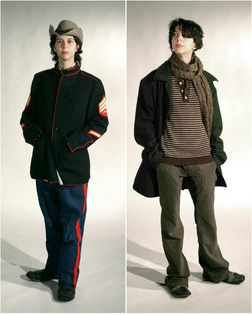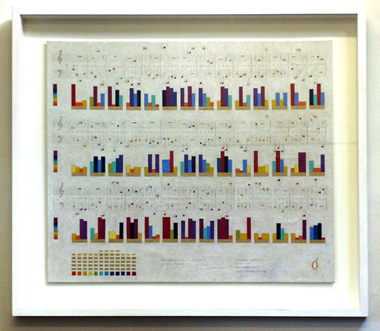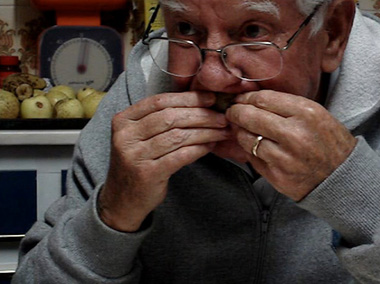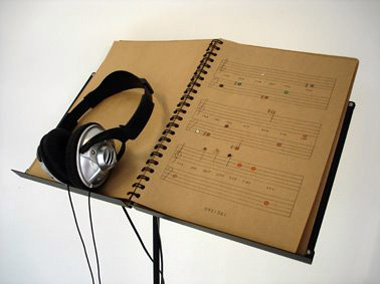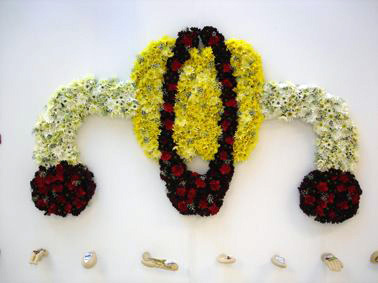Niall de Buitléar: Firstly I’d like to address your use of personae. You operate as both Ana Garcini, who makes work inspired by scientific research, and as Francisco J., whose work draws from religion. For me the pretence of the personae suggests a detachment which seems to be at odds with the apparent sincerity of the work which you have described as very emotional. Are these personae entirely constructs, or do they represent aspects of your own personality?
Priscila Fernandes: Both. The fragmentation of personality comes from an inherent necessity of playing different roles, placing myself as the ‘other’ in a particular social and intellectual background. It’s an attempt to comprehend my plurality of interests, conceivably result of a cognitive dissonance, and to understand my own identity.
The examination of the ‘self’ is also observed in Ana Garcini and Francisco J.’s artworks. Their artwork is equally concerned in defining their own identity, either by adopting a scientific methodology or by deconstructing cultural ideologies.
Besides, they inherited some of my interests, which then were developed originally and independently from myself, consequently acquiring their own characteristics and autonomous personality. Therefore, I like to consider them as alter-egos or heteronyms instead of simply role-play of personae.
I have been using the plurality of the ‘subject’ and crossing several disciplines in order to engage with the ways in which the ‘self’ can be theorized.
The construction of alter-egos, or heteronyms, is also a response to how systems of meaning and cultural representation multiply, arising around questions of identity and human behaviour. It’s an attempt to comprehend plurality and to understand the ‘self’ as a product of society.
I believe that the act of depersonalization is a good way of approaching this theme, since it involves a relationship between ‘self’ and ‘other’, individual and object, inner an outer. As Sartre putted it, “we must know how to say ‘we’ in order to say ‘I’.”
Moreover, by engaging with this multi-identity practice, I can be detached emotionally from the work that Garcini and Francisco produce. It’s easier to maintain a critical mind and to allow a more free experimentation of different mediums, concepts and formats, when being disconnected from my own constraints.
NDB: Could a third alter-ego be added to the mix in the future?
PF: It’s very possible; however it is also plausible to question to what extent the actual alter-egos will exist in the future…
NDB: I have seen the project involving the translation of the genetic code of a fruit fly into music in a number of forms. It was shown at The Lab as a sound piece with an accompanying score and then later at Four and the Green on Red as a more developed video piece showing an elderly person eating fruit in Portugal with flies swarming around and the orchestral version of the music as a soundtrack. Lee Welch (director of Four) suggested to me that the piece, for him, evoked death and decay. The fruit fly was chosen as it is commonly used in biology due to its genetic simplicity, but has there is a darker symbolism attached to the image of a fly. Are you interested in the potential for images from science to have an unexpected emotional resonance?
PF: After the translational systems were applied to a sequence of DNA of a fruit fly, Ana Garcini adapted the musical score to different instruments, assembling three final versions of the same piece – piano, digital orchestra, and a performance by a soprano opera singer. Her purpose is exactly to create diverse emotional resonances by repeating the same piece using a different ‘voice’ or giving it a different tone. Consequently, that gives a singular effect to the artwork, making us interact differently with the piece.
It is really interesting that the orchestra version has evoked death and decay, while the same piece performed with the opera singer seemed to suggest a more delicate or pleasant approach, and the piano version an apparent chaos.
The reason behind the choice of the genetic material of a fruit fly is because these insects are the most commonly used model organisms in biology (scientifically known as drosophila melanogaster).
In Drosophila melanogaster for orchestra , Garcini explores an open metaphor, linking the daily activity of eating fruit to the life cycle of a fruit fly. Ana Garcini is just showing a simple routine, thus connecting it to that specific soundtrack (DNA of fruit fly performed by a digital orchestra); she is influencing the emotional nature and atmosphere of the image. Furthermore, it’s gratifying for me, when the resonance of an artwork doesn’t end with the artist, but lives in disquietude in the minds of the viewers.
NDB: The music from the fruit fly piece ( Drosophila melanogaster ) sounds quite discordant. Did some structure emerge or would any random string of elements produce a similar result if the same translation system were applied?
PF: Using the same translation system in other sequences of DNA would obviously produce different results – each section of genetic data is singular. Consequently, every time that a genetic sequence is translated into music or painting, a portrait of the organism is being represented.
NDB: The random elements of the music created, as well as your use of ‘scores’ for various works as Garcini, suggests the influence of John Cage. Would that be true and do you indeed consider the work to be music?
PF: I’ve studied music since I was very young, and for me composing is just another way of expressing myself artistically.
I am very interested in John Cage’s, Steve Reich’s and Michael Feldman’s work. What essentially catches my attention is the inventiveness and conceptuality of their work. Furthermore, genetic music is, in my opinion, an interesting approach that recalls Cage’s assertion that music can be extracted from all the sounds around us, in this particular case, from everything including us.
I consider the work by Garcini as conceptual, musical and performative. Besides, I don’t think we can coherently be asked to separate what is music from art, noise from harmony, or even, music from science…
NDB: At the Open systems show at the Green on Red you also showed some drawings based on the molecular protein structure of avian influenza. What was your interest in Bird Flu? For me it seems to be an example of how science can be linked to fear. It seems to have disseminated as a news story through the media more effectively than biologically, so far at least.
PF: Two years ago, we were being warned of a deadly avian influenza virus pandemic. There was the fear of the possible mutation of the virus, which would easily become transmittable among humans, and soon create a massive number of casualties. Before that was SARS, the Ebola virus, mad cow disease, bio terrorism, and so on…
Although we understand that a virus epidemic is worthy of all our attention, the influenza virus (among others) was used as a sensationalist news story by the media. Fear can be effectively used as an instrument to control society – when we are afraid we obey.
Garcini proposed to study and analyse this topic by deconstructing the genetic material of H5N1 (bird flu) into drawings and musical performance.
NDB: It is clear that you have an interest in science but your relationship to religion is less clear and the work of Francisco J. has not been as widely seen as Garcini’s thus far. Are you personally religious or do you look at it as an outsider? The work of Francisco J. does also have a scientific element, specifically in the use of medical diagrams.
PF: I was brought up amidst a religious society and family. That had and still has a profound impact in my life and work. Francisco’s work reflects my upbringing in that same environment. He examines Christianity by deconstructing Christian iconography, superstition and cultural ideologies, in order to find his own principles. There is a scientific element in some of Francisco’s works used as an instrument to engage in a dialogue between scientific knowledge and superstition. These elements are essentially present in the artworks Hippocampus minor and the Wax organon cycle.
NDB : In the book Biology as ideology: the doctrine of DNA , Richard C Lewontin suggests that aspects of science that we often take as fact may actually be much more subjective and are actually part of a social construction. Could your work been seen to touch upon the room for subjectivity in science and objectivity in art?
PF: Yes, definitely. As Jean-François Doucet emphasized, “Scientific objectivity is simply a shared subjectivity.” Our conception of reality is shared universally and it is only significant as a reality-for-humans, and not significant as reality-itself.
My purpose when linking art and science is to create a paradigm between objectivity and subjectivity, transforming art in an objective reality and science in a subjective reality. That is very present in the heteronomy work of Ana Garcini, whose practice is not aimed at being scientifically objective and with statistical certainty, but inspired by human curiosity with a subjective reading of science, or social construction as Lewontin emphasized. Furthermore, this practice could be understood as similar to the scientific practices before 1800s, where truth to nature was associated with an artistic practice and philosophy, intended to idealize and connect the unreliable appearances of the given.
NDB: Artists drawing on science is something that is quite widespread these days and something I have dealt with a little in some of my own work. To what extent can artists really deal with scientific issues or adopt a scientific approach without merely borrowing superficial aesthetic details?
PF: I am aware of scientists who are able to admire the visual result of their scientific experiments as artistic. However, the scientist usually doesn’t consider himself as the creator of that result – there is an absence of the consciousness of authorship.
The fact that an artist engages with science can encourage an innovative aesthetic expression of what simply started as a scientific analysis.
In my point of view, an artwork inspired by science is not superficial when it raises questions, when it is used as a tool to comment on society and its system of rules; the development of new technologies; the conquests of science and how that affects us in our daily lives.
Furthermore, there are similar procedures in the practice of art and science. Both involve investigation, development of ideas, theories and hypotheses with the intention of studying materials, people, culture, history, religion, etc. History proves that the two disciplines cannot exist without each other. Leonardo da Vinci (whose works were usually informed by scientific investigation) and Georges Seurat (who studied the physics of colours, allowing him to develop a technique called Pointillism) are just some examples of how artistic and scientific investigation can be interestingly bound together.
Niall de Buitléar is an artist.
